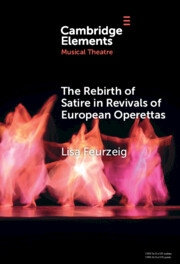Refine search
Actions for selected content:
194 results
Chapter 4 - The Other Within
-
- Book:
- Wales, Romanticism, and the Making of Imperial Culture
- Published online:
- 12 December 2025
- Print publication:
- 22 January 2026, pp 137-176
-
- Chapter
- Export citation
Chapter 12 - Ankh-Morpork, Anti-Utopia
- from Part IV - Case Studies
-
-
- Book:
- The Cambridge Companion to British Utopian Literature and Culture since 1945
- Print publication:
- 31 December 2025, pp 244-269
-
- Chapter
- Export citation
Chapter 13 - Ille Ego
- from Part III - Personal Ennius
-
-
- Book:
- Ennius Beyond Epic
- Published online:
- 10 December 2025
- Print publication:
- 18 December 2025, pp 292-314
-
- Chapter
- Export citation
Chapter 1 - Romeing across Genres
- from Part I - Multiform Ennius
-
-
- Book:
- Ennius Beyond Epic
- Published online:
- 10 December 2025
- Print publication:
- 18 December 2025, pp 15-37
-
- Chapter
- Export citation
Chapter 5 - Varro’s Menippean Ennius
- from Part I - Multiform Ennius
-
-
- Book:
- Ennius Beyond Epic
- Published online:
- 10 December 2025
- Print publication:
- 18 December 2025, pp 91-116
-
- Chapter
- Export citation
Chapter 11 - Ennius’ Saturae and the Registers of Personal Poetry
- from Part III - Personal Ennius
-
-
- Book:
- Ennius Beyond Epic
- Published online:
- 10 December 2025
- Print publication:
- 18 December 2025, pp 241-270
-
- Chapter
- Export citation
Chapter 1 - Hans Sloane’s Library
-
- Book:
- Hans Sloane's Library Collection and the Production of Knowledge
- Published online:
- 20 November 2025
- Print publication:
- 18 December 2025, pp 22-57
-
- Chapter
- Export citation
Chapter 2 - Epic Satire and Epiphanic Nostalgia in Mina Loy’s Anglo-Mongrels and the Rose
-
- Book:
- Nostalgia and National Identity in the British and Irish Modernist Epic
- Published online:
- 27 November 2025
- Print publication:
- 18 December 2025, pp 54-80
-
- Chapter
- Export citation
Introduction - Ennius Over-Annalized
-
-
- Book:
- Ennius Beyond Epic
- Published online:
- 10 December 2025
- Print publication:
- 18 December 2025, pp 1-12
-
- Chapter
- Export citation
Chapter 4 - The Reception of Ennius’ Saturae and Varia in Antiquity
- from Part I - Multiform Ennius
-
-
- Book:
- Ennius Beyond Epic
- Published online:
- 10 December 2025
- Print publication:
- 18 December 2025, pp 70-90
-
- Chapter
- Export citation
3 - Poetry in the Penal Colony
-
-
- Book:
- The Cambridge History of Australian Poetry
- Published online:
- 19 November 2025
- Print publication:
- 11 December 2025, pp 63-83
-
- Chapter
- Export citation
The Disinformation Dilemma: Moderating Political Satire Under the DSA in Light of the European Convention on Human Rights
-
- Journal:
- European Journal of Risk Regulation , First View
- Published online by Cambridge University Press:
- 18 November 2025, pp. 1-16
-
- Article
-
- You have access
- Open access
- HTML
- Export citation
Chapter 13 - Satirical Street Literature
- from Part III - New Genres
-
-
- Book:
- African Literature in Transition
- Published online:
- 23 October 2025
- Print publication:
- 06 November 2025, pp 257-274
-
- Chapter
- Export citation
Chapter 1 - “Every Common Reader”
-
-
- Book:
- British Law and Literature in the Long Eighteenth Century
- Published online:
- 19 September 2025
- Print publication:
- 09 October 2025, pp 25-44
-
- Chapter
- Export citation
Chapter 5 - Hoodoo Conversions
-
- Book:
- Manufacturing Dissent
- Published online:
- 03 October 2025
- Print publication:
- 21 August 2025, pp 166-210
-
- Chapter
- Export citation
Ficción, sátira y moral en la prensa rioplatense de comienzos del siglo XIX: De Antonio Valdés a Francisco de Paula Castañeda
-
- Journal:
- Latin American Research Review / Volume 60 / Issue 4 / December 2025
- Published online by Cambridge University Press:
- 04 July 2025, pp. 851-870
-
- Article
-
- You have access
- Open access
- HTML
- Export citation
Chapter 29 - Modern Hebrew Realism
- from Part IV - Locations of Realism
-
-
- Book:
- Realism and the Novel
- Published online:
- 05 June 2025
- Print publication:
- 19 June 2025, pp 415-427
-
- Chapter
- Export citation
A CRUX IN JUVENAL (6.195)
-
- Journal:
- The Classical Quarterly , First View
- Published online by Cambridge University Press:
- 04 June 2025, pp. 1-5
-
- Article
-
- You have access
- Open access
- HTML
- Export citation
A Seven-Headed Public: Empire and Satire in Revolutionary Caucasus
-
- Journal:
- Comparative Studies in Society and History / Volume 67 / Issue 3 / July 2025
- Published online by Cambridge University Press:
- 21 May 2025, pp. 622-653
-
- Article
-
- You have access
- Open access
- HTML
- Export citation

The Rebirth of Satire in Revivals of European Operettas
-
- Published online:
- 20 May 2025
- Print publication:
- 19 June 2025
-
- Element
- Export citation
